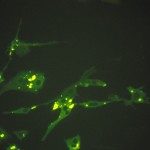Lien vers Pubmed [PMID] – 12526053
J. Med. Virol. 2003 Mar;69(3):408-16
The first complete genome sequence of Dobrava hantavirus isolated from yellow-necked mouse Apodemus flavicollis trapped in the northeastern Greece is described. The S, M, and L segments of the Greek isolate of Dobrava virus are 1673, 3635, and 6532 nucleotides (nt) long, respectively, and encode the nucleocapsid (N) protein of 429 amino acids (aa), glycoprotein precursor of 1135 aa, and the L protein of 2151 aa. N protein contains three cysteine residues conserved in all known hantaviruses, as well as structural domains responsible for the RNA binding and presumable interaction with the apoptosis enhancer Daxx. All cysteine residues and glycosylation sites that are conserved among G1G2 sequences of all hantaviruses species were also found in the Greek isolate. The L protein contains all the polymerase motifs and structural domains found in other hantavirus polymerases. Comparison of the Greek isolate of Dobrava virus with other hantaviruses showed the highest level of sequence homology with Dobrava virus isolate from Slovenia. Other hantaviruses carried by Murinae rodents (Saaremaa, Hantaan, Seoul, and Thailand viruses) were more divergent and hantaviruses carried by Arvicolinae or Sigmodontinae rodents showed the highest genetic diversity with the Greek isolate of Dobrava. The results of phylogenetic analyses confirmed these observations and showed a monophily of all the Dobrava virus strains that, in turn, shared more ancient ancestors first with Saaremaa virus and then with other Murinae-borne hantaviruses.

